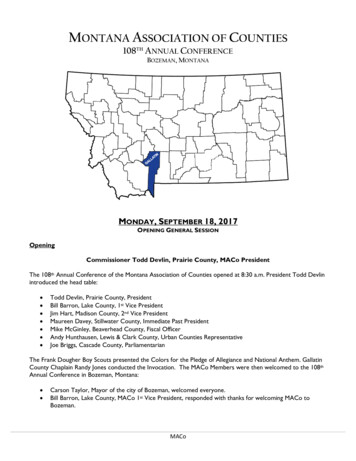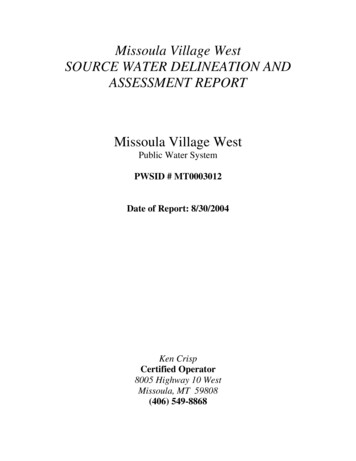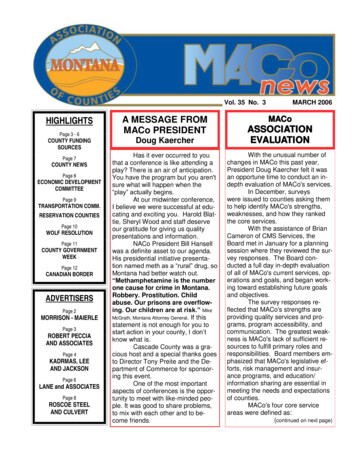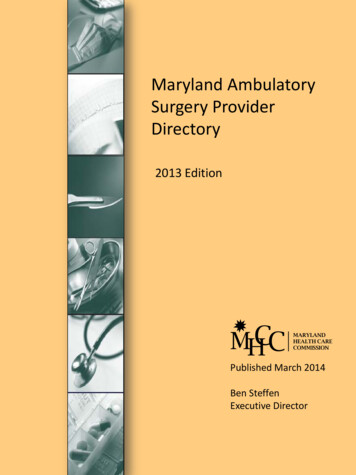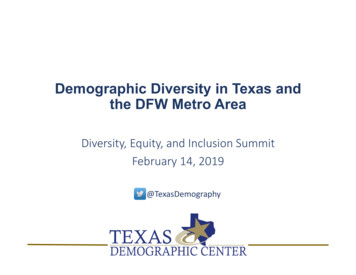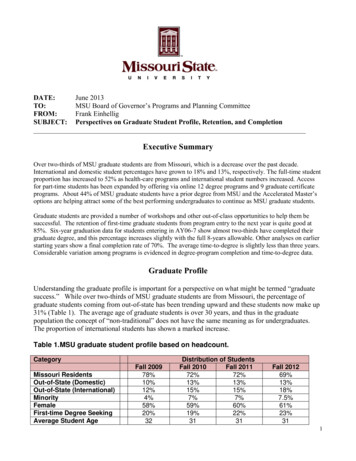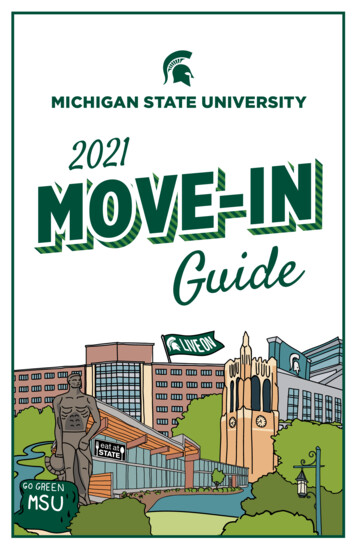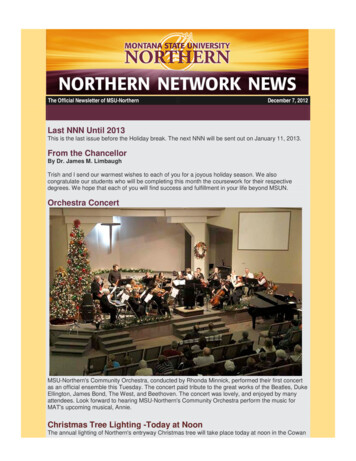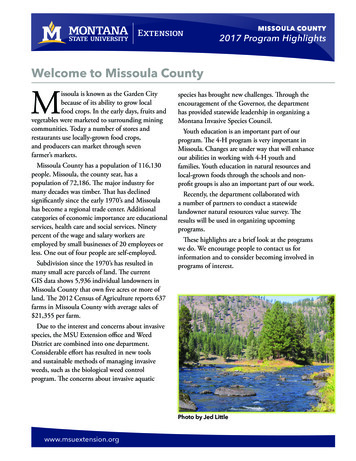
Transcription
MISSOULA COUNTY2017 Program HighlightsWelcome to Missoula CountyMissoula is known as the Garden Citybecause of its ability to grow localfood crops. In the early days, fruits andvegetables were marketed to surrounding miningcommunities. Today a number of stores andrestaurants use locally-grown food crops,and producers can market through sevenfarmer’s markets.Missoula County has a population of 116,130people. Missoula, the county seat, has apopulation of 72,186. The major industry formany decades was timber. That has declinedsignificantly since the early 1970’s and Missoulahas become a regional trade center. Additionalcategories of economic importance are educationalservices, health care and social services. Ninetypercent of the wage and salary workers areemployed by small businesses of 20 employees orless. One out of four people are self-employed.Subdivision since the 1970’s has resulted inmany small acre parcels of land. The currentGIS data shows 5,936 individual landowners inMissoula County that own five acres or more ofland. The 2012 Census of Agriculture reports 637farms in Missoula County with average sales of 21,355 per farm.species has brought new challenges. Through theencouragement of the Governor, the departmenthas provided statewide leadership in organizing aMontana Invasive Species Council.Youth education is an important part of ourprogram. The 4-H program is very important inMissoula. Changes are under way that will enhanceour abilities in working with 4-H youth andfamilies. Youth education in natural resources andlocal-grown foods through the schools and nonprofit groups is also an important part of our work.Recently, the department collaborated witha number of partners to conduct a statewidelandowner natural resources value survey. Theresults will be used in organizing upcomingprograms.These highlights are a brief look at the programswe do. We encourage people to contact us forinformation and to consider becoming involved inprograms of interest.Due to the interest and concerns about invasivespecies, the MSU Extension office and WeedDistrict are combined into one department.Considerable effort has resulted in new toolsand sustainable methods of managing invasiveweeds, such as the biological weed controlprogram. The concerns about invasive aquaticPhoto by Jed Littlewww.msuextension.org
Plant & Pest EducationMissoula Plant Clinic keeps residents inthe know about plants and their pestsThe Missoula County MSU Extension PlantClinic provides leadership and educationalopportunities to the public on the identificationand integrated pest management practices(IPM) of plant diseases, pests and related planthealth problems through the coordination andmanagement of the Plant Clinic. The clinic:§§ Performs weekly scouting trips, checking onpest levels that challenge gardeners, landscapersand homeowners in maintaining healthy plantcommunities and environment.§§ Traps for insects such as the codling moth,cherry fruit fly and currant/gooseberry flyto give Missoula County residents timelyinformation on when to spray for those pests tocontrol damage to fruit. This information helpsreduce unwarranted pesticide use.§§ Updates the Pest Alert Hotline, which isdistributed through email, Missoula CountyMSU Extension website and phone recording.§§ Provided information for 1,600 calls, walkin clients and emails this year includinginformation on soil testing, pruning, plantidentification, and pest control.§§ Collaborates with the YMCA’s Gardeningfor Kids Camp. Thirty children were givenmagnified bug viewing containers to examineprovided lady bugs. We talked about good andbad bugs in the garden and what role bugs play.§§ Assisted the City of Missoula Parks departmentby training 10 volunteers how to maintainplants in traffic circles.§§ Participates in two radio talk shows answeringhorticulture questions from listeners.§§ Partners with FCS Agent Kelly Moore inteaching four Lunch and Learn classes: subjectsinclude Stevia, fruit leather, beet growing andharvesting, and growing herbs.§§ Held a class for 10 people on how to growsalad greens in containers (Seed to Salad).§§ Works with the local native plant society andU of M maintenance on diagnosing problemsin their native plant garden at the University ofMontana.ABOVE: Talking about good and badbugs in the garden with the YMCAyouth gardening class.RIGHT: Lady beetle larva pupatinginto adults.2MISSOULA COUNTY Montana State University Extension
Partnerships: Refining Outreachthrough Social UnderstandingIn 2013, the weed district brought togetheran interdisciplinary group of natural resourcemanagers, social scientists, and conservation leadersto work collaboratively to find ways to improveoutreach effectiveness and enhance natural resourcestewardship in Montana. Natural resources issuesidentified by the group included mitigating theimpacts of wildfire, wildlife conflict and invasiveweeds. With funding provided by the MissoulaCounty Weed District, Montana Department ofNatural Resources, Gallatin Valley Land Trust,Defenders of Wildlife, Montana State UniversityExtension and the Montana Department ofAgriculture, the group partnered with the HumanDimensions Lab of theUniversity of Montana toconduct a statewide surveythat could provide a betterunderstanding of landowners’attitudes and values towardkey natural resource issues,constraints, and preferencesfor information sources. Thisinformation could then beused to clearly identify groupsof Montana landowners mostin need of assistance anddevelop audience appropriatemessaging and informationfor them. The survey wascompleted in 2016, and hereare the results of Landowners’perspectives on weed controlacross Montana.controlling weeds on their property wouldmotivate their neighbors to take action.§§ While 70% of landowners reported checkingtheir property for weeds, only 40% oflandowners thought their neighbors weretaking action.§§ 80% of landowners are willing to useherbicides to help control noxious weedson their property; only 44% of landownerswere willing to apply for a government grantprogram to do so.§§ Friends and family and general internet searchwere the most popular sources people usedto get info. Workshops/classes and federalgovernment were the least popular sources.§§ 70% of landowners saidthey always checked theirproperty for weeds.§§ Almost 90% of landownersbelieved their personalactions could help controlweeds, only 31% ofrespondents believed thatwww.msuextension.org3
Montana Biocontrol Coordination ProjectThe Montana Biocontrol Coordination Project works toprovide the leadership, coordination, and educationnecessary to enable land managers across Montana tosuccessfully incorporate biological weed control intotheir noxious weed management programs.In 2017:§§ 35 days were spent collecting insects§§ Nearly 500 land managers assisted in collectingbiocontrol agentsCyphocleonus achates-spotted knapweedroot weevil§§ 7 species were collected (Mecinus janthiniformis,Mecinus janthinus, Agonopterix alstroemeriana,Aphthona spp, Oberea erythrocephala, Larinus spp,and Cyphocleonus achates)§§ 3 additional species were brought in and released inMontana (Chrysolina spp, Hylobius tranversovittatus,and Puccinia punctiformis)§§ 40 Montana counties collected or received insects§§ 14 other states received insects (Colorado,Washington, Idaho, Nevada, Oregon, Arizona, Utah,New Mexico, Wyoming, Nebraska, South Dakota,Minnesota, Tennessee, and New York)§§ Approximately 2.5 million insects distributed§§ 16,520 acres treated (following rule of: 5 acrestreated for every 1 release)§§ 550,000 approximate market value of distributedinsects§§ 15 workshops were coordinated or presentationswere given in Columbus, Kalispell, Miles City,Missoula, Ovando, Deer Lodge, Dixon, Condon,Philipsburg, Whitehall, Browning, Fishtail, and Utica§§ Over 300 participants were involved in theseworkshops or presentations§§ Nearly 6,750 miles traveled throughout Montana forworkshops and collectionsLarinus spp – spotted knapweed flower weevil4MISSOULA COUNTY Montana State University Extension
Grocery shopping tours with MissoulaEFNEPFamily and Consumer Sciences 2017Program HighlightsThe Expanded Food and Nutrition EducationProgram (EFNEP) provides free classes to lowincome families in Missoula County. Classgraduates have the opportunity to attend a groceryshopping tour. Families receive a 10 gift card andare challenged to make a healthy meal consistingof all five food groups according to MyPlate.EFNEP partners with Super Walmart, a store thatis convenient and familiar to families. During the2016-2017 fiscal year, nutrition educators JuliaGoar and Bonnie Medlin conducted six tours.§§ Powerful Tools for Caregivers. Two sessionswere offered in spring and fall, in partnershipwith MAS (Missoula Aging Services). Twentyparticipants got information and peer supportin groups. Participants are better able to utilizeresources shared in class to ensure improvedself-care during the challenges of familycaretaking.Recently, while touring the bread aisle, BonnieMedlin asked her participants to grab the breadthey normally buy and identify the fiber content.MyPlate teaches that a whole grain productis defined as 3g of fiber or more. One of herparticipants was shocked to discover that hernormal bread purchase only contained 1g offiber. She was tricked into thinking the bread waswhole grain based off the color of the bread. Theparticipant then chose to buy a loaf of whole grainbread with a higher fiber content.Missoula EFNEP 2016-2017 Statistics§§ 95 families graduated.§§ 89% of families had a positive change, eatingmore of the five food groups. Graduates atemore food with fiber, calcium, and Vitamin A.§§ 8.12 is saved in healthcare costs by a familywho graduated from EFNEP.§§ DEEP (Diabetes Empowerment EducationProgram). Two sessions were offered in springand fall with 15 participants. Universityof Montana Pharmacy School seniorspresented updates on diabetes medicationsand management progress. Empowermentstrategies are adopted by participants to betterhandle the challenges of diabetes self-careand management. The Community DiabetesEducation Program presented the doctorreferred program for those with diabetes tocontinue to expand their diabetes awareness.§§ Strong People. Two, six-week sessions of lowimpact exercises and strength training (witha nutrition component) were offered for anaverage of 6-8 seniors ranging in age from 5594 at River Ridge Senior Apartments. Severalparticipants expressed their excitement abouthaving more energy and endurance as a resultof the program.§§ 884 children reached in the 2016-2017 schoolyear.Canning demonstration and pressure gaugetesting at Caras Nursery.Missoula EFNEP nutrition educator Bonnie Medlin leadinga shopping tour at Walmart.www.msuextension.org5
§§ ServSafe. This program was taught in May andNovember to 25 participants from Missoulaand Ravalli Counties, in partnership withRavalli County MSU Extension at BitterrootCollege.§§ Lunch and Learn. Offered from Octoberthrough May, these one-hour lunchtime classesgave information and demonstrations on localfoods, and how to grow and cook them. Classeslike ‘Seeds to Salads,’ and ‘Growing and EatingFennel’ averaged 8-12 participants.§§ Canning Class Series. Three weekly eveningclasses were offered for making: pickle relish,apple pie filling, and pressure canning chickenat Moonlight Kitchens. Participants said theywould continue canning classes throughout theyear if offered. Several had never canned beforeand are planning on continuing as a result.§§ Cooking Classes and Canning Demonstrationswere given at the Indian Health CenterWellness Fair at University of Montana, AceHardware, Montana Outdoor RecreationExpo, Nine Mile Community Center FoodPreservation Update, Good Food Store LocalRIGHT: Lunchand Learn: Ediblearrangements.BELOW: Womenin AgricultureConference atMissoula CountyMSU Extension.6MISSOULA COUNTY Montana State University ExtensionFoods Fair, Missoula Aging Services SeniorCorp Volunteers FCS Program Update, andMissoula Food Bank. Tests were done on 45pressure gauges.§§ Missoula County MSU Extension FCS servedas the Western Montana host site for WomenIn Agriculture (WSU sponsored), with 20participants from around the state.§§ MSU School of Nursing Project. MissoulaCounty MSU Extension FCS served as apreceptor for two nursing students who workedon children’s pre-diabetes education.Ambassador program helps 4-H teenssucceed at lifeThe 4-H Ambassador program in MissoulaCounty teaches teens how to be better leaders,communicators and community-minded citizens.Participation in the program causes teens tobe more confident, outspoken and aware oftheir position as role models in the community.Seasoned 4-H Ambassadors make new friendsmore easily, they force themselves outside ofcomfort zones and they participate in statewide4-H events at a much higher rate than nonAmbassador 4-H teens.By their own admission, through responses toquestions on the 4-H Ambassador application,55% of applicants wanted to participate in theAmbassador program specifically because of theleadership development opportunities. Another55% of applicants indicated a desire to give backto the 4-H program from which they had gainedso much, by promoting 4-H in the communityand mentoring younger members.
Several quotes from Ambassador applicants arenoteworthy:§§ I remember being a little kid and looking up tothose who wore the ambassador shirts. I wantto be that leader for the kids now. To be theleader I needed when I was younger.§§ Being an ambassador has helped to developmy leadership, communication and publicspeaking skills. It has also motivated me tobecome the best person I can possibly be.§§ I learned that there are different kinds ofleaders. Knowing that made me feel morecomfortable and secure when leading because Iprefer not to be in the spotlight.§§ I learned that being a leader has no breaks andthat you always have someone looking up toyou.§§ Being an ambassador has helped me to takemore risks and try new things.§§ In my classes, I started speaking up andvolunteering information and not being afraidthat it was wrong.§§ Before, I was scared to do my own thing andto stand up for myself, now I focus on doingwhatever I’m doing at a 100% level also,now I make decisions based on what I think isright or best, no matter if my friends are doingsomething different.§§ Being an ambassador has helped me to makenew friends and improve my social life.§§ Having a goal has focused me and made mehappier. Now I have a direction, and now Iknow how to get things done and be a goodleader. I have found a family with the groupof ambassadors, a safe space. So that gives memore confidence.In 2017, all of the 12 teens from Missoulawho traveled to Helena for the 4-H LegislativeBreakfast event were Ambassadors. Eightysix percent of Missoula’s teens who traveledto Miles City for Montana 4-H Rec Labwere Ambassadors, and Missoula’s delegationto Montana 4-H Congress in Bozeman wascomprised of 52% Ambassadors, 48% nonAmbassadors. All of these 27 teens competed inState 4-H contests while in Bozeman. The 4-HCouncil Board in Missoula believes strongly inthe positive impact the Ambassador programhas on youth, and as a result, they invest nearly 8,000 annually to support their travel to andparticipation in state- and national-level 4-Hevents and competitions.LEFT: 4-H Ambassadorsprepare to serve lunchwhile volunteering atthe Poverello Center inMissoula.CENTER: Missoula 4-HAmbassadors experience some Central Montanaculture while road tripping home from Montana 4-HRec Lab in Miles City.FAR RIGHT: Missoula 4-H Ambassadors enjoy atour of the State Capitol building following 4-HLegislative Breakfast.www.msuextension.org7
contact us:Missoula County2825 Santa Fe CourtMissoula, MT 59808(406) orgCampbell BarrettExtension AgentGerald MarksExtension AgentKelly MooreFCS Extension AgentDiann PommerEFNEP Extension AgentJulia GoarNutrition EducatorBonnie MedlinNutrition EducatorSandy PerrinPlant ClinicHorticulturistSharon GaffneyAdministrative SupportColleen TerrazasAdministrative SupportMontana State University Extension is an ADA/EO/AA Veteran’s Preference Employer and provider of educational outreach.
Missoula County has a population of 116,130 people. Missoula, the county seat, has a population of 72,186. The major industry for many decades was timber. That has declined significantly since the early 1970's and Missoula has become a regional trade center. Additional categories of economic importance are educational
